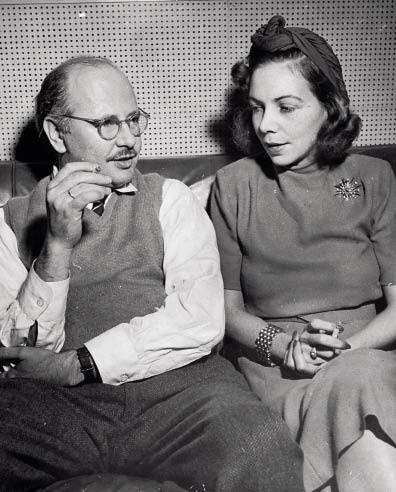Virginia Cowles was a 27-year-old American journalist working for the Hearst newspapers when she went to Spain for the first time. It was March 1937; the battle of Guadalajara had just brought a victory to the Republicans and besieged Madrid was an exciting place to be. Up till then, Cowles had reported mainly on events of a ‘peaceful nature’. Spain would turn her into a war reporter.
Arriving at the Hotel Florida with her suitcase and typewriter, an elegant, resourceful young woman with a high forehead and dark brown hair, she was soon part of the gang of foreigners cheering the Republicans on. There was the bulky Tom Delmer from the Daily Express, in whose room she ate sardines and crackers and listened to Beethoven’s Fifth Symphony.
With Hemingway, Martha Gellhorn, Herbert Matthews and Josephine Herbst, all of whom would leave descriptions of these months in Madrid, she filed her stories from the Telephone Building in Gran Via and went to drink in fashionable Chicote’s. Bright yellow trams rattled down the cobbled streets, Sciaparelli scent was on sale in the shops and Greta Garbo was starring in Anna Karenina. A soldier offered her his rifle to take a pot shot at ‘los facciosas’. Professor Haldane wandered around absent-mindedly in a tin hat and breeches left over from the first world war, and a chicken was found to feed the ‘red’ Duchess of Atholl. When Cowles went with Hemingway to interview Madrid’s chief executioner, Hemingway said to her ‘He’s mine’, and put him in his play about fifth columnists.
What made Cowles different, however, was that she intended to cover the war from both sides. Sympathetic to the Republican cause, she was not blind to its atrocities, and unlike Martha Gellhorn, whose phrase ‘all that objectivity shit’ came to immortalise the partisan nature of reporting, she spent as many weeks with the Nationalists, attending their trials and writing about the German and Italian soldiers serving with them. Looking for Trouble contains a memorable scene of a picnic of potatoes and red wine in bright sunshine watching shrapnel rain down like black soot on the final offensive against the losing Republicans, in the company of a major who longed only to be back at his job taking photographs for Vogue. It was, she writes, like a ‘mad tea-party from the pages of a bellicose Alice in Wonderland’.
By now bitten by the camaraderie and the adrenalin of war-reporting, Cowles kept going. She went backwards and forwards across Europe, to Prague, Berlin, Paris and London, interviewing generals and statesman, politicians and journalists. In her pieces, she kept warning of impending war. A natural reporter, with an eye for the absurd and the telling detail, she describes seeing Lord and Lady Redesdale in Nuremberg, there to accompany the Hitler-worshipping Unity, who told Cowles that Hitler had assured her that there wouldn’t be a war, because he did not want to see his new buildings bombed. Lord Redesdale reminded her of a figure out of P. G. Wodehouse, looking as if he were at an awkward country-house party at which no one, peculiarly, spoke English.
By the time war was finally declared, Cowles had been made a roving correspondent for the Sunday Times, moving from capital to capital watching the ‘lights in the death-chamber go out one by one’. She was in Berlin the day Germany launched its attack on Poland, in Helsinki as the Russians invaded Finland, and she reached Paris when the Germans were just 17 miles from the city, and most of the inhabitants of the capital were on the roads in the great exodus to the south. It was war reporting of a long gone era, when journalists were not embedded but ranged freely, when they stayed naturally in the Ritz in Paris and the Adlon in Berlin, when they met up, wherever they were, with other legendary correspondents with whom they drank copiously and covered battles in an amiable and mostly unrivalrous way.
Cowles had the added advantage of being exceptionally well-connected. When in London, she went to Chartwell to see Churchill. In Nuremberg, she was part of a very small group to have tea with Hitler, Himmler, Göring, Heydrich and Goebbels. She dined with Duff Cooper, during Chamberlain’s ‘peace with honour’ period, who told her that he might not have resigned from the Cabinet had Chamberlain returned from Munich saying ‘peace with terrible, unmitigated, unparalleled dishonour’. Bold, tenacious and tireless, she made the most of her introductions. Air Marshal Italo Balbo took her flying in a two-seater plane over Tripoli. Mussolini gave her an interview the week he launched his attack on Abyssinia.
Cowles always liked England. She found its calm and staunchness reassuring and in between visits to the theatres of war, she returned to London with unfailing pleasure. Published in 1941, long before Pearl Harbor, her book ends with a celebration of the British wartime spirit, and a rousing call to America to
fight side by side with Great Britain until we reach a victory so complete that freedom will ring through the ages to come with a strength no man dare challenge.
After the war, Cowles returned to England, married the member of parliament and journalist Aidan Crawley, wrote a play with Martha Gellhorn about women reporters at the war front, and went on to publish 13 books on such subjects as the Romanovs, the Astors and the Rothschilds.
Looking for Trouble is a reminder of how excellent a reporter she was, with an easy, independent tone and considerable understanding for the ordinary people whose lives were ruined by war. Full of good anecdotes, descriptions of little remembered campaigns and agreeable digressions on food, weather, clothes and travel, it is hard to put down.
Caroline Moorehead is the author of Martha Gellhorn: A Life.






Comments